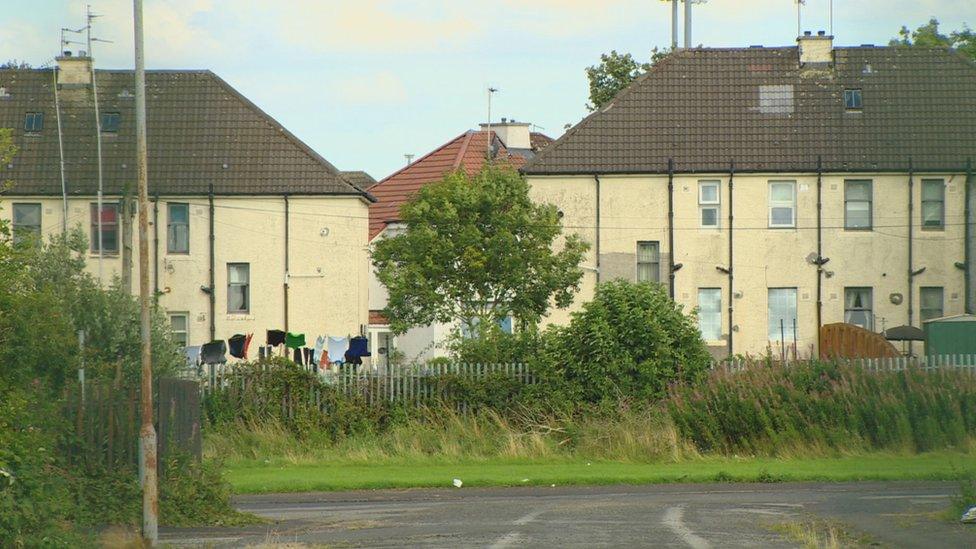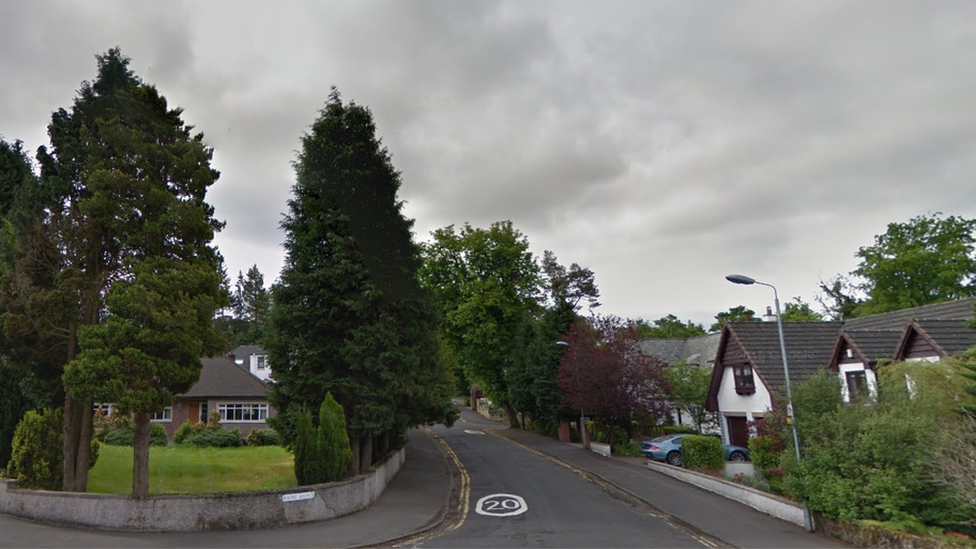Ferguslie Park named as Scotland's most deprived area
- Published

It is the second successive time that Ferguslie Park has been at the bottom of the deprivation index
Ferguslie Park in Paisley has been identified as the area of Scotland with the greatest level of deprivation.
It is the second successive time the area has been at the bottom of the Scottish Index of Multiple Deprivation, external (SIMD), which is published every four years.
Statisticians rate almost 7,000 areas in Scotland by standards including income, employability and health.
Lower Whitecraigs in East Renfrewshire is classed as the least deprived.

The least deprived area in Scotland was Lower Whitecraigs
Glasgow has 56 of the 100 most deprived areas, down five on 2012.
Edinburgh has six, up two on four years ago.

The 10 most deprived areas in Scotland:
Ferguslie Park, Paisley
Carntyne West and Haghill, Glasgow City
North Barlanark and Easterhouse South (Area 1), Glasgow City
Old Shettleston and Parkhead North, Glasgow City
Nitshill, Glasgow City
Muirhouse, City of Edinburgh
Possil Park, Glasgow City
Cliftonville, North Lanarkshire
Drumchapel North, Glasgow City
North Barlanark and Easterhouse South (Area 2), Glasgow City
The 10 least deprived areas in Scotland:
Lower Whitecraigs and South Giffnock, East Renfrewshire
Midstocket, Aberdeen City
Marchmont West (Area 1), City of Edinburgh
St Andrews South West, Fife
Comely Bank, City of Edinburgh
Joppa, City of Edinburgh
Marchmont West (Area 2),City of Edinburgh
Hilton, Aberdeen City
Kilmardinny East, East Dunbartonshire
Bruntsfield, City of Edinburgh

Renfrewshire Council, which covers the area including Ferguslie Park, said a long-term plan to change the area's fortunes was already under way.
Council leader Mark Macmillan said: "The council has adopted an innovative approach to tackling poverty, recognised as leading the way in Scotland - and the SIMD stats are based on data from last year which does not fully capture the impact of that.
"The figures show the overall picture for Renfrewshire has improved and we believe we are making a difference on the ground.
"In the four years since the last SIMD figures were released, Renfrewshire has seen a 10% real-terms drop in the cash coming our way from Holyrood.
"The deprivation issues affecting Ferguslie and similar areas are long-term and deep-rooted - there are no easy solutions but through our unique approach, we believe we are on the right track."
Welfare reform
The Scottish government said the figures showed "why Scotland needs a government committed to tackling deep-seated deprivation, poverty and inequalities".
Communities Secretary Angela Constance said: "This will not be an easy job while we do not have the full levers of power, but I am determined we take on the challenge of making a generational change for those areas that have been in poverty for too long.
"In the face of continuing UK government welfare cuts, an austerity agenda and attempts to take Scotland out of Europe, this will continue to be a long-term challenge."
She added: "We are spending £100m protecting people against the worst effects of welfare reform and every pound spent on mitigation measures is a pound less that can be spent on lifting people out of poverty."
The Scottish Conservatives said the figures should be a "wake-up call" to the SNP government.
Equalities spokeswoman Annie Wells said: "There are many causes of deprivation - poverty, family breakdown, drug and alcohol abuse, low educational standards and poor health and we now need a new approach.
"Powers need to be devolved from the Scottish government to enable cities and city-regions to work more closely together to regenerate and redevelop their local economies."
'Too unequal'
Scottish Labour's deputy leader Alex Rowley said: "If we are serious about cutting the gap between the richest and the rest we need to fully understand the picture of poverty in Scotland.
"These numbers are an important start - and they show a Scotland which remains too unequal, and further SNP cuts will only make it worse.
"The most deprived communities in Scotland will suffer more because of hundreds of millions of pounds of cuts to schools and local services, whilst our health boards are faced with millions of pounds of cuts because the SNP aren't giving our NHS the resources it needs."
Scottish Greens spokeswoman Alison Johnstone MSP said: "If we're to boost incomes, employment chances and health, we need to see greater ambition from Scottish ministers and local authorities. Yes, the Westminster government's continuing agenda of cuts plays a part, but we cannot let that stop us.
"We can push further on a real Living Wage across our economy, and we can boost people's health by committing to a major programme of housebuilding and energy efficiency measures, along with better public transport and cycling and walking infrastructure."



Analysis by Reevel Alderson, BBC Scotland Home affairs correspondent
The Scottish Index of Multiple Deprivation (SIMD) is published every four years.
It provides the government and local authorities with a considerable amount of information aimed at helping them tackle the problem.
The index breaks Scotland down into 6,976 "datazones", effectively small postcode areas, and ranks levels of deprivation there on seven criteria.
These are: income, employment, health, education, housing, access to services and crime.
Overall scores are then provided for each datazone.
But that is not the full picture.
The statisticians say "deprived" does not just mean "poor" or "low income".
It can also mean people have fewer resources and opportunities, for example in health and education.
One area may score well on educational outcomes for example, but have poor health and access to services.
The Scottish government says this "allows effective analysis for targeting of policies and funding where the aim is to wholly or partly tackle or take account of area concentrations of multiple deprivation."

